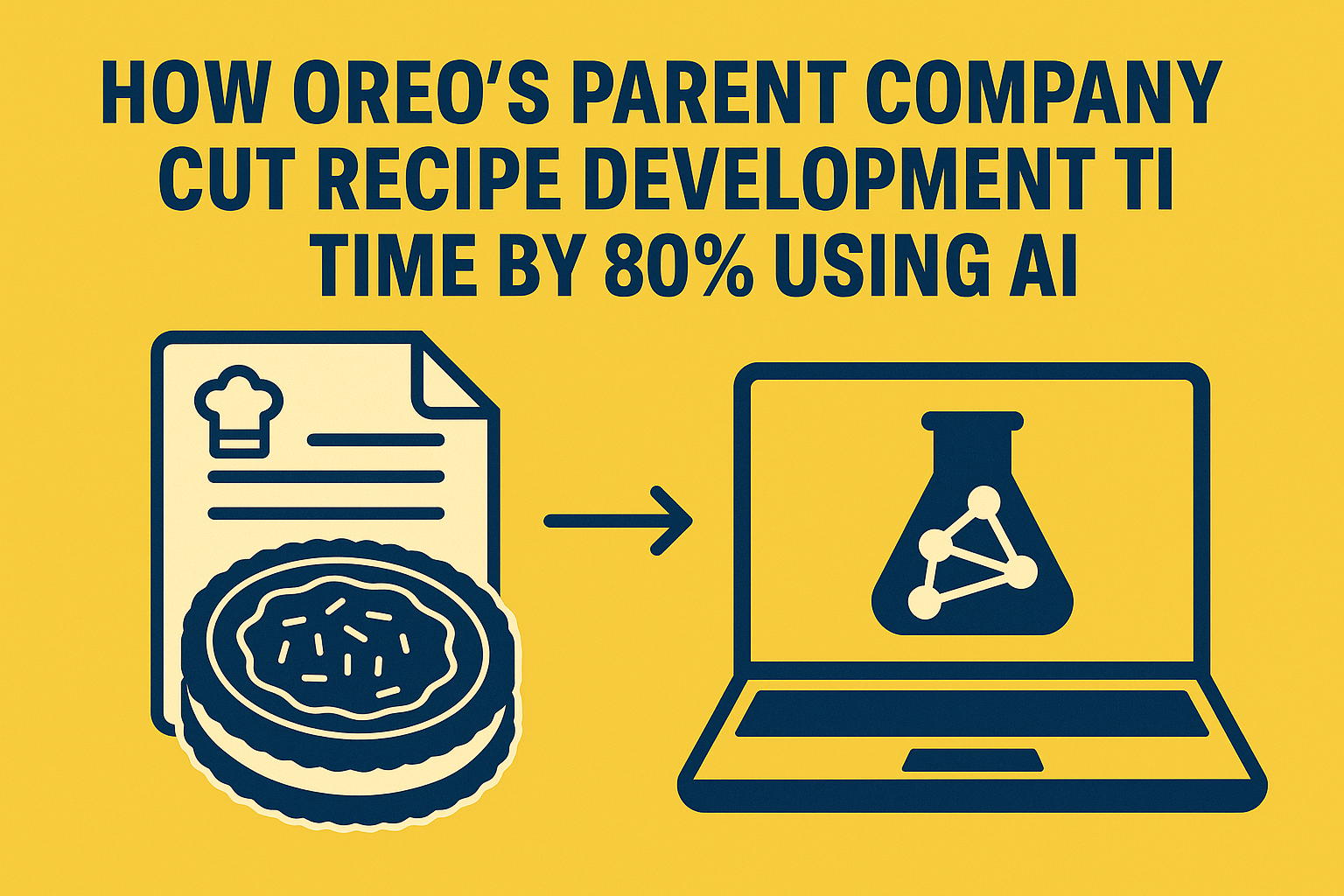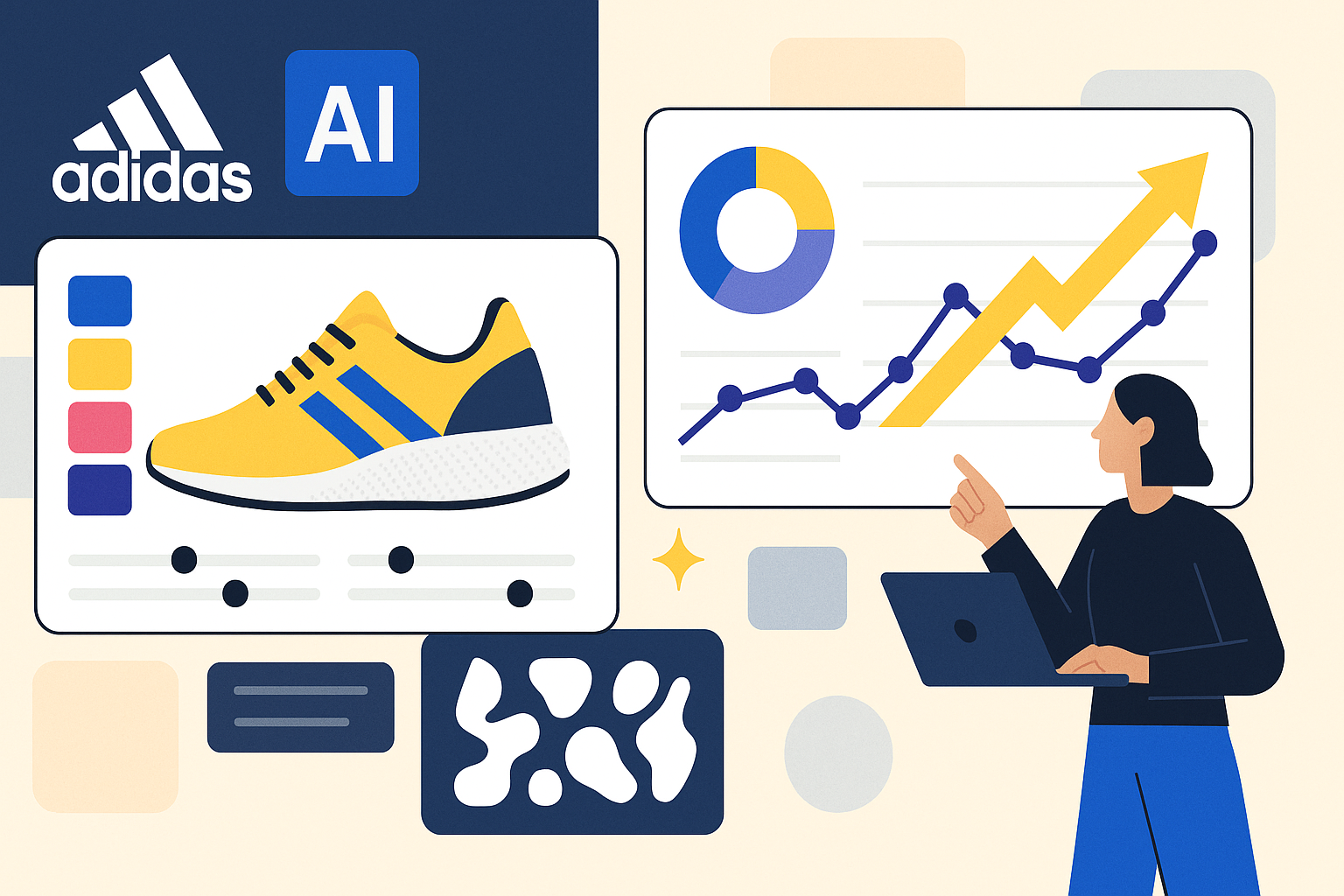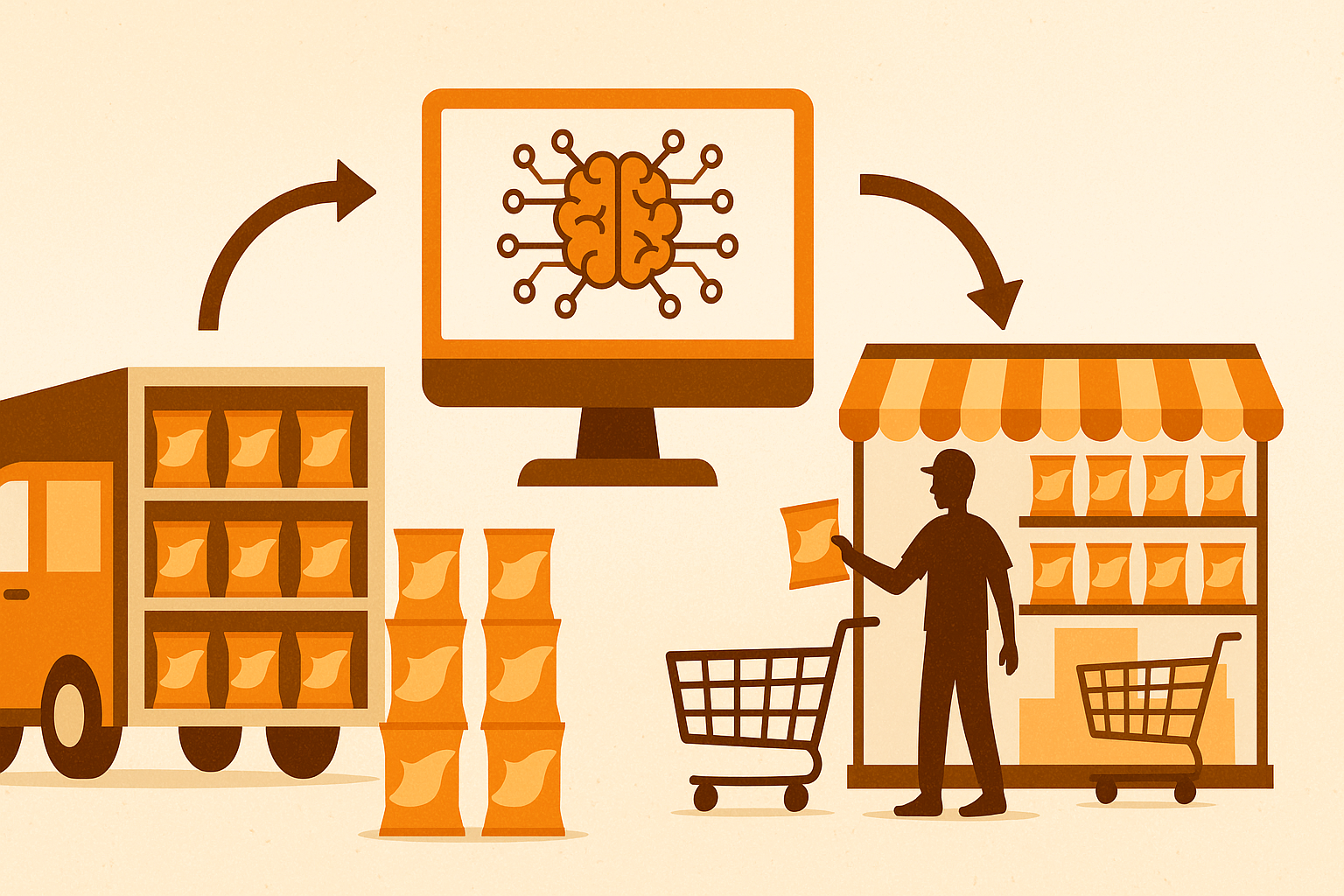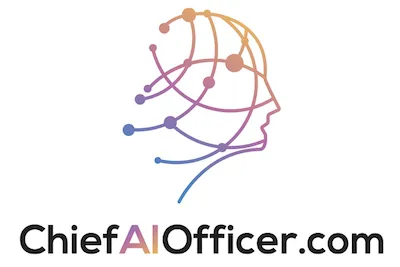Mondelez can now take a snack concept from initial idea to production trial four to five times faster than traditional methods. Not by hiring more food scientists. Not by adding more test kitchens. By feeding decades of recipe data into AI systems that can instantly calculate how adding 3% more butter will affect both flavor intensity and manufacturing costs.
This isn’t about replacing human taste testers with algorithms. It’s about something more subtle and potentially more revolutionary: using AI to explore the combinatorial explosion of ingredient possibilities that human food scientists could never test in their lifetimes.
The result? Over 70 unique products developed using this approach, including gluten-free Oreos that actually taste like Oreos and reformulated classics that maintain their iconic flavor profiles while meeting new nutritional standards.
The Hidden Bottleneck in Food Innovation
Traditional recipe development operates on timescales that make no sense in modern consumer markets. A food scientist wants to create a new cookie flavor. They formulate a recipe based on experience and intuition, mixing ingredients in specific ratios. The mixture goes to a test kitchen for small-batch production. Samples get distributed to taste panels. Feedback comes back. Adjustments get made. The cycle repeats.
Each iteration takes weeks or months. Factor in supply chain coordination, ingredient sourcing, cost analysis, and nutritional compliance testing, and you’re looking at 12-18 month development cycles for products that might fail in market testing anyway.
The math gets worse when you consider the exploration problem. A typical cookie recipe might include 15-20 ingredients, each with possible variations in quantity, quality, and processing method. The number of potential combinations exceeds what any team could test even with unlimited time and budget.
Mondelez realized the bottleneck wasn’t creative thinking or taste expertise. It was the physical limitation of mixing, baking, and tasting one recipe at a time. You can’t shortcut the baking process, but you can shortcut the exploration process that decides what to bake.
The AI Recipe Intelligence System
Mondelez’s proprietary AI system analyzes vast datasets of existing recipes, ingredient combinations, consumer taste preferences, manufacturing constraints, and cost parameters. The key innovation isn’t the AI itself but what it was trained on: decades of institutional knowledge about how ingredients interact, what consumers prefer, and how recipes translate from test kitchen to factory production.
The system allows product developers to specify desired attributes across multiple dimensions simultaneously. Want a cookie that’s 15% more buttery tasting, uses 20% less sugar, maintains the same texture profile, costs no more than $1.23 per pound to produce, and reduces environmental impact by 10%? The AI can generate recipe candidates that optimize across all these constraints at once.
Traditional recipe development requires sequential optimization. First you get the taste right, then you adjust for cost, then you modify for nutrition, then you rework everything because the nutritional changes destroyed the taste. Each adjustment potentially undoes previous work, creating lengthy back-and-forth cycles.
AI-powered recipe formulation optimizes everything simultaneously. The system understands the relationships between variables, so it proposes recipes that balance competing constraints rather than requiring sequential trade-offs.
I’ve seen similar dynamics in software engineering, where developers used to manually optimize code for speed, then memory usage, then readability, with each optimization potentially undoing previous work. Automated optimization tools that consider all variables simultaneously didn’t just save time. They found solutions humans wouldn’t discover because the solution space was too complex for sequential exploration.
The Four to Five Times Faster Reality
The headline claims four to five times faster development cycles, but understanding where that speed comes from reveals something interesting about innovation bottlenecks. The AI doesn’t make ovens heat faster or taste tests happen quicker. It dramatically reduces the number of physical iterations required.
Traditional development might test 40-50 recipe variations to find one that meets all requirements. The AI system analyzes thousands of potential recipes virtually, identifying the 5-8 most promising candidates for physical testing. Those candidates have much higher success rates because they’ve already been optimized for all constraints before any ingredients get mixed.
The practical timeline looks like this: Product developers define desired attributes (flavor profile, texture, cost, nutrition, sustainability). The AI generates optimized recipe candidates within hours or days. The top candidates go to test kitchen production. Taste panels evaluate physical samples. Minor adjustments get made based on feedback. The refined recipe moves to production trials.
What used to take 12-18 months now happens in 3-4 months. The speed advantage compounds because faster iteration enables more innovation attempts with the same resources. If you can test three times as many product concepts in the same timeframe, you can be more ambitious with innovation or more responsive to emerging trends.
The Gluten-Free Oreo Achievement
Creating gluten-free versions of iconic products represents one of the hardest challenges in food science. Gluten isn’t just an ingredient. It’s a structural protein that affects texture, moisture retention, and the characteristic “snap” of cookies like Oreos.
Traditional gluten-free baking substitutes alternative flours and binding agents, but these substitutions fundamentally change the product’s texture and flavor. Most gluten-free versions of classic cookies taste noticeably different, which is why many consumers avoid them despite dietary needs.
Mondelez used their AI system to explore combinations of alternative ingredients that could replicate gluten’s functional properties without using wheat-based proteins. The system analyzed how different flour blends, binding agents, and processing methods affected texture, analyzing thousands of potential formulations to identify candidates that could match the original Oreo’s characteristics.
The result was a gluten-free Oreo that maintains the distinctive texture and flavor profile that makes Oreos recognizable. This wasn’t possible through traditional trial-and-error development because the solution required a specific combination of ingredients and processing methods that human food scientists were unlikely to test together.
The Optimization Dimensions Nobody Discusses
The really sophisticated part of Mondelez’s system isn’t optimizing for taste or cost individually. It’s optimizing across dimensions that have complex interdependencies:
Flavor Intensity: Not just “more vanilla” but specific intensity levels that match consumer preference data for different markets and demographics.
Aroma Profile: The smell compounds that affect perceived taste even before consumers bite into the product.
Visual Appearance: Chip distribution in cookies, surface texture, color consistency, and other visual attributes that affect purchase decisions.
Environmental Impact: Carbon footprint of ingredient sourcing, water usage in production, and packaging sustainability.
Nutritional Profile: Sugar content, fat ratios, protein levels, and vitamin fortification possibilities.
Manufacturing Constraints: Ingredients that work in test kitchens but cause problems in high-volume production lines.
Ingredient Costs: Real-time pricing data for raw materials across global supply chains.
Shelf Stability: How long products maintain freshness under various storage conditions.
Traditional recipe development might consider 3-4 of these dimensions. AI-powered formulation can optimize across all of them simultaneously, finding solutions in the multi-dimensional space that human food scientists would never explore because the complexity exceeds manual calculation capabilities.
The Brand Steward Safety Net
Here’s the part that addresses the obvious concern: How do you ensure AI-generated recipes maintain brand identity? Mondelez uses “brand stewards,” experienced food scientists who understand what makes each brand distinctive, as the final checkpoint before recipes advance to production.
The AI generates optimized candidates. Brand stewards evaluate whether those recipes maintain the essential characteristics that define the brand. An Oreo must taste like an Oreo. A Ritz cracker must have that distinctive buttery flavor and flaky texture. AI optimization can’t compromise the core attributes that make products recognizable to consumers.
This human-AI collaboration model splits responsibilities strategically. AI handles the computational heavy lifting of exploring massive solution spaces and optimizing across multiple constraints. Humans make the subjective judgments about brand identity and taste quality that require intuition developed through years of experience.
The result is faster innovation without the risk of algorithmic optimization destroying the brand attributes that drive consumer loyalty. The AI expands what’s possible. Humans ensure what’s possible still feels authentic to the brand.
The Market Responsiveness Advantage
Consumer preferences shift faster than traditional product development can respond. A health trend emerges on social media, gains mainstream attention, and becomes a significant purchasing factor within 6-8 months. Traditional 12-18 month development cycles mean products designed to capitalize on trends launch after peak interest has already passed.
Mondelez’s accelerated development timeline enables trend-responsive innovation. When plant-based diets became mainstream, they could develop and launch plant-based snack variations quickly enough to capture consumer interest during peak demand periods. When consumers started prioritizing sustainable sourcing, they could reformulate products to highlight sustainably sourced ingredients while the trend was still building momentum.
This creates competitive advantages beyond just being first to market. It reduces the risk of investing heavily in product development for trends that fade before launch. Faster development means smaller investment per attempt, enabling more experimental innovation without proportionally higher risk.
The 70 Products Reality Check
Mondelez has developed over 70 unique products using this AI-powered approach. This number deserves context because it reveals something about how AI changes innovation economics.
Traditional development’s high cost and long timeline mean companies must be highly selective about which concepts to pursue. Each product development attempt represents significant investment, so only the most promising ideas get greenlit. This creates conservative innovation portfolios focused on incremental improvements to existing successful products.
AI-powered development’s lower cost and faster timeline enable more experimental innovation. When each attempt costs less and fails faster, companies can afford to test more ambitious concepts. Some will fail, but the overall portfolio generates more breakthrough successes because more diverse concepts get tested.
The 70 products include both safe iterations on existing brands and more experimental innovations that wouldn’t have been greenlit under traditional development economics. Some succeeded commercially. Others provided valuable learning about consumer preferences. The key shift is that failure became cheaper, enabling more ambitious experimentation.
The Supply Chain Integration
The really sophisticated aspect of Mondelez’s AI implementation extends beyond recipe formulation into supply chain optimization. The AI system connects to real-time ingredient pricing data, allowing it to optimize recipes not just for taste and nutrition but for current market conditions.
Commodity prices fluctuate constantly. Cocoa prices spike due to weather events in West Africa. Vanilla prices surge following tropical storms in Madagascar. Traditional recipe formulation uses historical average costs, meaning production teams often discover mid-manufacturing that ingredient costs have shifted significantly from original projections.
AI-powered formulation incorporates current pricing data into optimization calculations. If cocoa prices spike temporarily, the system can suggest minor recipe adjustments that maintain taste profile while reducing cost impact. If vanilla prices drop, it can identify opportunities to enhance flavor intensity cost-effectively.
This creates dynamic recipe optimization that responds to market conditions rather than locking in ingredient specifications that may become economically suboptimal. The practical impact shows up in profit margins that remain stable despite commodity price volatility.
The Sustainability Calculation Nobody Expected
Environmental impact optimization wasn’t part of the original AI system design. It emerged as a natural extension once the infrastructure existed to optimize across multiple variables. Adding carbon footprint and water usage as optimization constraints required connecting the recipe formulation system to lifecycle analysis databases tracking environmental impact of different ingredients and production methods.
The interesting discovery was that sustainability and cost optimization often align. Ingredients with lower environmental impact frequently cost less because they require less resource-intensive production. Processing methods that reduce energy consumption also reduce manufacturing costs. The AI system identifies these win-win opportunities that human developers might miss because they’re optimizing for one variable at a time.
Mondelez can now develop products that explicitly optimize for reduced environmental impact without sacrificing taste or significantly increasing costs. This wasn’t possible through traditional development where sustainability was treated as a constraint to work around rather than a dimension to optimize for.
The Consumer Preference Data Loop
The AI system becomes more effective over time as it incorporates consumer feedback data from launched products. Taste test results, sales performance, online reviews, and social media sentiment all feed back into the training data, improving the system’s ability to predict which recipes will succeed commercially.
This creates a compounding advantage similar to other AI applications. Early adopters build proprietary datasets that make their systems increasingly effective compared to competitors starting later. The recipes Mondelez tested in 2022 improve their AI’s recommendations in 2025. Competitors launching similar systems in 2025 lack that accumulated learning.
The feedback loop also enables micro-optimization that traditional development never attempted. Small adjustments to existing successful products based on consumer feedback data can be tested virtually before any physical production. This enables continuous improvement of existing product lines alongside development of entirely new products.
The Regional Customization Opportunity
Taste preferences vary dramatically across markets. Asian consumers prefer different sweetness levels than European consumers. Latin American markets favor different texture profiles than North American markets. Traditional global brands either accept one-size-fits-all recipes or invest heavily in region-specific formulation.
AI-powered recipe development changes this economic calculation. Developing regional variations costs only incrementally more than developing a single global recipe because most work happens virtually. The system can generate region-optimized variations simultaneously, each tailored to local taste preferences while maintaining core brand identity.
This enables global brands to offer localized products without the traditional cost multiplier associated with regional customization. A cookie brand can have slightly different recipes in different markets, each optimized for local preferences while maintaining the characteristics that make it recognizable as the same brand globally.
The Talent Implications
Mondelez’s food scientists aren’t spending less time on innovation. They’re spending their time differently. Instead of manually mixing variations and waiting for results, they’re defining optimization parameters, evaluating AI-generated candidates, and making strategic decisions about which innovations to pursue.
The job shifted from execution-heavy to strategy-heavy. Food scientists now need to understand how to specify optimization constraints, interpret AI recommendations, and make informed judgments about which algorithmic suggestions align with brand strategy. This requires different skills than traditional recipe development but not necessarily less expertise.
The teams that struggle most with this transition are those treating AI as a replacement for human judgment rather than an amplification of human judgment. The AI excels at exploring vast solution spaces and optimizing across multiple constraints. Humans excel at subjective evaluation, strategic prioritization, and maintaining brand integrity.
The Competitive Pressure Building
Mondelez’s success creates pressure across the food industry. Competitors watching from the sidelines face increasing disadvantages in speed, cost efficiency, and innovation throughput. The question shifts from “should we adopt AI-powered recipe development?” to “how quickly can we implement it before the competitive gap becomes insurmountable?”
Smaller food companies face particular challenges because developing proprietary AI systems requires significant upfront investment in data infrastructure, model development, and system integration. The companies that can afford early adoption build advantages that smaller competitors struggle to match.
This suggests potential consolidation dynamics where larger food companies with resources to invest in AI-powered innovation gain market share from smaller competitors still using traditional development methods. The speed and cost advantages compound over time, creating widening performance gaps.
The Innovation Pipeline Transformation
The traditional innovation funnel assumed high failure rates at each stage. Generate 100 concepts, develop 20 recipes, test 5 products, launch 1 success. The economics required conservative risk management because each stage represented significant investment.
AI-powered development inverts this model. The system can evaluate hundreds or thousands of concepts virtually before any physical development begins. This front-loads the failure process, eliminating poor candidates before expensive physical testing. The concepts that advance to physical development have much higher success rates because they’ve already passed rigorous virtual optimization.
The practical result is innovation pipelines that test more ambitious concepts with lower overall risk. Companies can pursue breakthrough innovations alongside incremental improvements because the cost of exploring ambitious concepts decreased dramatically. Some will still fail, but the portfolio economics support more experimental innovation than traditional methods enabled.
Your Strategic Response Depends on Scale
For major food companies, the imperative is clear: invest in AI-powered recipe development or accept competitive disadvantages in speed, cost, and innovation throughput. The technology exists, the ROI is demonstrable, and early adopters are already building compounding advantages through accumulated training data.
For smaller food companies, the calculation is more nuanced. Building proprietary AI systems may be economically impractical, but leveraging third-party platforms or partnering with AI development firms could provide access to similar capabilities without the full infrastructure investment.
For startups, AI-powered recipe development enables innovation approaches that were previously accessible only to major corporations. The ability to virtually test thousands of recipe variations before any physical production reduces the capital required for food product development, lowering barriers to entry in categories dominated by established brands.
The Future of Food Innovation
The trajectory is clear: food development is shifting from physical iteration to virtual optimization. The companies that understand this transition and build their innovation processes accordingly will dominate their categories. Those that continue optimizing traditional development methods will find themselves permanently disadvantaged by slower cycles and higher costs.
Mondelez proved that AI-powered recipe development isn’t theoretical. It’s production-ready, commercially viable, and delivering measurable competitive advantages. The 70+ products they’ve developed using this approach represent the leading edge of a transformation that will eventually reshape how all food gets developed.
The question isn’t whether AI will transform food innovation. It’s whether your company will be among the leaders capturing early advantages or among the followers playing catch-up after the competitive gap has widened beyond easy closing.
Gluten-free Oreos that actually taste like Oreos aren’t just a product achievement. They’re proof that the future of food innovation arrived faster than anyone expected.




